Fog Computing in Healthcare: Systematic Review
Abstract
Healthcare has seen many advances in sensor technology, but with recent improvements in networks and the addition of the Internet of Things, it is even more promising. Current solutions to managing healthcare data with cloud computing may be unreliable at the most critical moments. High response latency, large volumes of data, and security are the main issues of this approach. The promising solution is fog computing, which offers an immediate response resistant to disconnections and ways to process big data using real-time analytics and artificial intelligence (AI). However, fog computing has not yet matured and there are still many challenges. This article presents for a computer scientist a systematic review of the literature on fog computing in healthcare. Articles published in six years are analysed from the service, software, hardware, information technologies and mobility with autonomy perspectives. The contribution of this study includes an analysis of recent trends, focus areas and benefits of the use of AI techniques in fog computing e-health applications.
1Introduction
Healthcare is one of the most expensive industries because it is person-centred and requires individual evaluations by healthcare workers. Integrating new technologies based on individual evaluation for general and preventive healthcare can reduce costs and offer real-time evaluation. As the populations of many countries age, the health system is facing an increasing burden, so additional technological solutions that could increase the availability of healthcare services while maintaining the appropriate quality must be sought.
The popularity and availability of Internet of Things (IoT) devices opened new opportunities to expand medical care and services not only in medical facilities and hospitals, but also in the homes of patients. IoT devices reduce the number of healthcare personnel because real-time assessment can be done without the intervention of a healthcare professional. The digital transformation in e-health combines information gathering, processing, communication (health data transmission and networks), and management (Maki et al., 2022) that are essential to healthcare delivery and depend on system hardware and software components that work with healthcare computing technologies.
Many current electronic healthcare systems are based on cloud computing to store and process large amounts of data created by edge devices. However, due to high latency, this approach alone may not be viable because of bandwidth limitations, latency issues and unpredictable network disruptions (Linthicum, 2017). To address high latency, fog computing could be the right solution that addresses not only long response times but also bandwidth issues caused by the vast amounts of data sent by medical devices.
Rapid response, scalability, device variety, mobility, wireless access, real-time data analysis, emergency notifications, low power consumption, security and privacy with depersonalised data – all of this may be offered by fog computing, which began to develop in 2010 when CISCO telecommunications company workers spoke for the first time about it. Then, in 2011 and 2012, the first scientific works appeared on fog computing in connected vehicle architecture (Bonomi, 2011) and fog computing role in IoT (Bonomi et al., 2012). Since then, the fog computing term has been successfully established. Fog computing, in general, is computing and storage resources located near edge devices. Fog computing devices operate physically and function between edge devices and the cloud.
The goal of fog computing is to increase efficiency, performance, and reduce the amount of data sent to the cloud in which it must be processed, analysed, and stored (Al-Fuqaha et al., 2015), also to reduce the data processing load on data centres and edge devices, which have limited resources. The data collected by the sensors are collected, processed and stored in a temporary database of the fog node device, rather than being transmitted to the cloud, thus avoiding mutual and network traffic data delays. Fog nodes are also known as gateways, and in addition to a simple network function, they have storage and processing capabilities. Such a fog node device can perform data preprocessing and part of the cloud computing processing close to the devices within the (IoT) ecosystem, thus enabling a faster response to events compared to the cloud.
The fast decision-making process is critical for e-health applications that transmit data for remote real-time processing over the network. The purpose of such programs is to actively monitor patients and processes, thus providing valuable information to enable conclusions. Long delay in such decision-making process, communication of emergency and giving timely treatment may be fatal. In such situations, fog computing facilitates a very fast and secure response by reducing the transmission of the network to the remote cloud (Kanani and Padole, 2020).
Many of the current review articles focus on simply listing existing technologies, services, applications, and problems, thus not providing a deeper formal analysis from particularised viewpoints (cf. Section 4). Our goal in this work is to summarise the technology concerning fog computing being applied and to identify promising directions for its use in healthcare. In this work, we will provide a systematic look at fog computing in healthcare by analysing scientific articles published in the last 6 years in chosen perspectives such as services, software, hardware, information technologies, and mobility with autonomy, and then we will look deeper into the area of currently booming AI techniques used in healthcare fog computing solutions.
2Methods
This systematic review of the literature provides a research overview of fog computing in healthcare. We verify and quantify the research evidence from the different perspectives chosen. The methods we applied to the systematic review of the literature were based on the following activities:
1. Research questions – formulation of research questions.
2. Search strategy – outlining the strategy and the libraries of scientific articles explored.
3. Selection of articles – explanation of the criteria for article selection.
4. Quality assessment – description of the quality assessment of the selected articles.
5. Distribution of articles – presentation of the chronological distribution of the studies.
6. Processing of results – description of the main methods used to process the results.
Fig. 1
Systematic review workflow with PRISMA.

2.1Research Questions
The formulation of the research questions is one of the first steps in a systematic review of articles. In this way, we try to perform a classification from chosen perspectives that are related to fog computing and healthcare. In line with the goal of this review, to provide a computer scientist with a detailed analysis of the latest research done on fog computing in e-health, we formulate the following research questions:
Q1. What are the recent trends and focus areas in fog computing e-health applications?
Q2. What are the benefits of using artificial intelligence (AI) techniques for fog computing in e-health?
2.2Search Strategy
The main objective of the search strategy was to find relevant work related to fog computing and healthcare. We had defined the scope of the search and keywords by selecting the most important words related to the topic of the investigation for broader results. The search strategy consisted of constructing keywords to query related work in the field of fog computing and healthcare. The keywords “fog” and “health” were used for the resulting search string to select articles.
The article search was performed by topic, including the title, abstract, and author keywords. We manually analysed the coverage of fog and healthcare information in terms of topic relevance and context. In the search phase, the articles were obtained from databases applying the created keywords using the Web of Science article search tool, which is maintained by Clarivate Analytics. The following are main full content electronic databases to which we had access: ACM Digital Library, Elsevier, Emerald Insight, Hindawi, IEEE Xplore, MDPI, SpringerLink, Tech Science Press, and Wiley Online Library.
To limit the scope of the search, the year range from 2017 to 2022 was set, and then all search results were manually filtered by selecting the article by hand.
2.3Selection of Articles
All articles that were not relevant to the topics of fog computing and healthcare were removed. The following exclusion criteria were used:
• The article does not address fog computing using “fog” or related acronyms.
• The article does not address healthcare using “health” or related acronyms.
• The article does not address AI (when answering the research question Q2).
Initially, articles that fall under search criteria were filtered by document type. These include, e.g. conference papers, journal articles, books, or book chapters. The articles were then filtered by year. Subsequently, articles whose title, abstract, or keywords did not mention fog computing and healthcare terms were excluded. Finally, if we were still not sure about the article, we carefully read it to ensure that what we are looking at is related to fog computing and healthcare. Finally, irrelevant articles were removed.
2.4Quality Assessment
The quality assessment criterion was chosen to verify that the article is a relevant study that is necessary to evaluate. We evaluate the selected articles considering the purpose of the investigation, contextualisation, literature review, related work, methodology, result, and conclusion according to the objectives and indication of future studies.
Quality assessment criteria used in the systematic review:
• The purpose of the research is clearly stated.
• The main contribution: original research, review, or analysis is present.
• The work has research results.
• The conclusions are related to the research objectives.
2.5Distribution of Articles
Fig. 2
Distribution of articles – number of relevant and irrelevant articles.
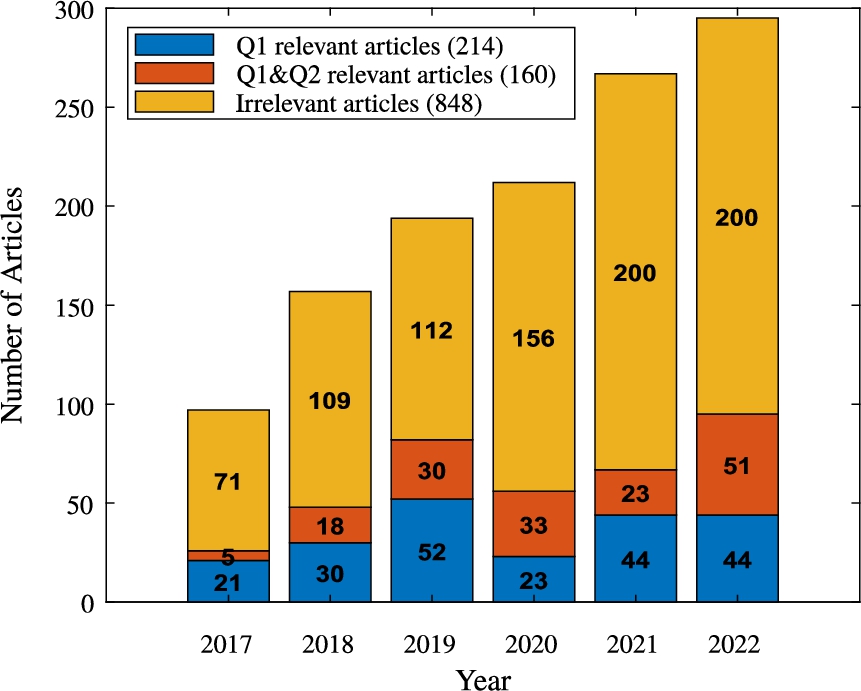
To structure the search results, we allocated articles by year to be able to see yearly trends. Figure 2 shows the selection process and how the filtering process of the articles works. Before using the exclusion criteria, we found 1222 articles in the preliminary search, of which 848 (69%) articles were considered irrelevant (5 articles failed quality assessment). Therefore, the final selection was of 374 articles (31%) that were used to answer the research questions.
2.6Processing of Results
The processing results for the first research question Q1 included the identification of five perspectives and the allocation of found terms into these categories: services, software, hardware, information technologies, and mobility with autonomy. All article data in the tables were presented annually (2017–2022), while individual table rows, representing the number of articles that elaborate on the specific term, were sorted out according to the total number of such articles. Using the statistical significance level of 5% (term was considered not significant if it was below 5% of the sum of all used terms), we determined significant terms (in the context of perspective under the consideration) and in tables separated them from the rest by a line. Moreover, only for the significant terms, we determined the maximum uses of the terms in the period of our investigation and additionally in the tables outlined them with the grey background. In order to extract the main trend based on the number of articles that elaborate on particular significant terms, we presented the data graphically using the line fitting-to-data technique.
The processing results for the second research question Q2 included the identification of three perspectives and the allocation of found terms into these categories: computational intelligence, machine learning, and neural networks. For each perspective, all the data about the article was presented in two types of tables. The first-type tables summarise the total number of articles (published from 2017 to 2022), when individual table rows, representing the total number of articles that elaborate on the specific term (technique), were sorted in decreasing order. Using the statistical significance level of 5% (term is considered not significant if the number of its uses is below 5% of the total sum of all used terms), we determined significant terms (in the context of perspective under consideration) and in tables separated them from the rest by a line. Also, with the grey background in these tables, we outlined the best techniques, i.e. techniques for fog computing that scored the highest accuracy in e-health applications. The second-type tables present data on comparative research studies of techniques (in the context of perspective under consideration) listing achieved accuracy, e-health application, investigated and the best techniques. The table rows are sorted in the accuracy decreasing order and, for convenience, are additionally labelled by process type: classification (C), detection (D), identification (I), optimisation (O), prediction (P), and recognition (R). With the grey background in these tables, we also outlined the significant terms from the first-type tables.
3Results
Here, the actual findings based on the methodology presented and structured according to the research questions raised are summarised. Their comparison with other reviews outcomes is given afterwards in the discussion section.
3.1The Recent Trends and Focus Areas in Fog Computing E-Health Applications
The most important perspectives for the developers of fog computing e-health applications that we identified are services, software, hardware, information technologies, and mobility with autonomy. We have chosen services, software and information technologies perspectives to give insight to computer science specialists, while hardware and mobility with autonomy perspectives to give insight to computer engineers, because connectivity everywhere is becoming widely used and opens more ways to gather and process data. We present the results of the answer to the first research question in these five perspectives.
3.1.1Services Perspective
In total, 14 most common terms that describe services in fog computing e-health applications were chosen and used to get a view of the first perspective. Table 1 summarises the results on these terms appearing in a representative set of articles.
Table 1
The number of articles that in 2017–2022 addressed a service in fog computing e-health applications.

From the data in the table it becomes evident that there are only six significant service-related terms (distinguished from the rest by a horizontal line) in the literature on fog computing e-health applications: monitoring, framework, architecture, data security, alert generation and prediction. “Monitoring” is the term most frequently used in articles, with a number of uses up to three times as low as any other term considered. All significant terms use maximum numbers (marked with the grey background) that vary from 16 to 46 times and appeared in the last year.
Fig. 3
Total annual mentions of significant terms of services and their linear approximation.

The main trends of the use of significant terms are shown in Fig. 3. From the pictorial representation in the figure it is clear that all six significant terms are trending, i.e. their use during the years 2017–2022 is increasing. It is seen that five terms during the years 2020 and 2021 had a decrease, though their use in 2022 peaked.
3.1.2Software Perspective
Software is an important part of the fog computing of e-health that is responsible for network simulation and verification, application front-end, back-end operation, and the operating environment. In total, 21 most common terms describing software in fog computing e-health applications were chosen to gain a view of the second perspective. Table 2 summarises the results on these terms appearing in a representative set of articles.
Table 2
The number of articles that in 2017–2022 addressed a software in fog computing e-health applications.
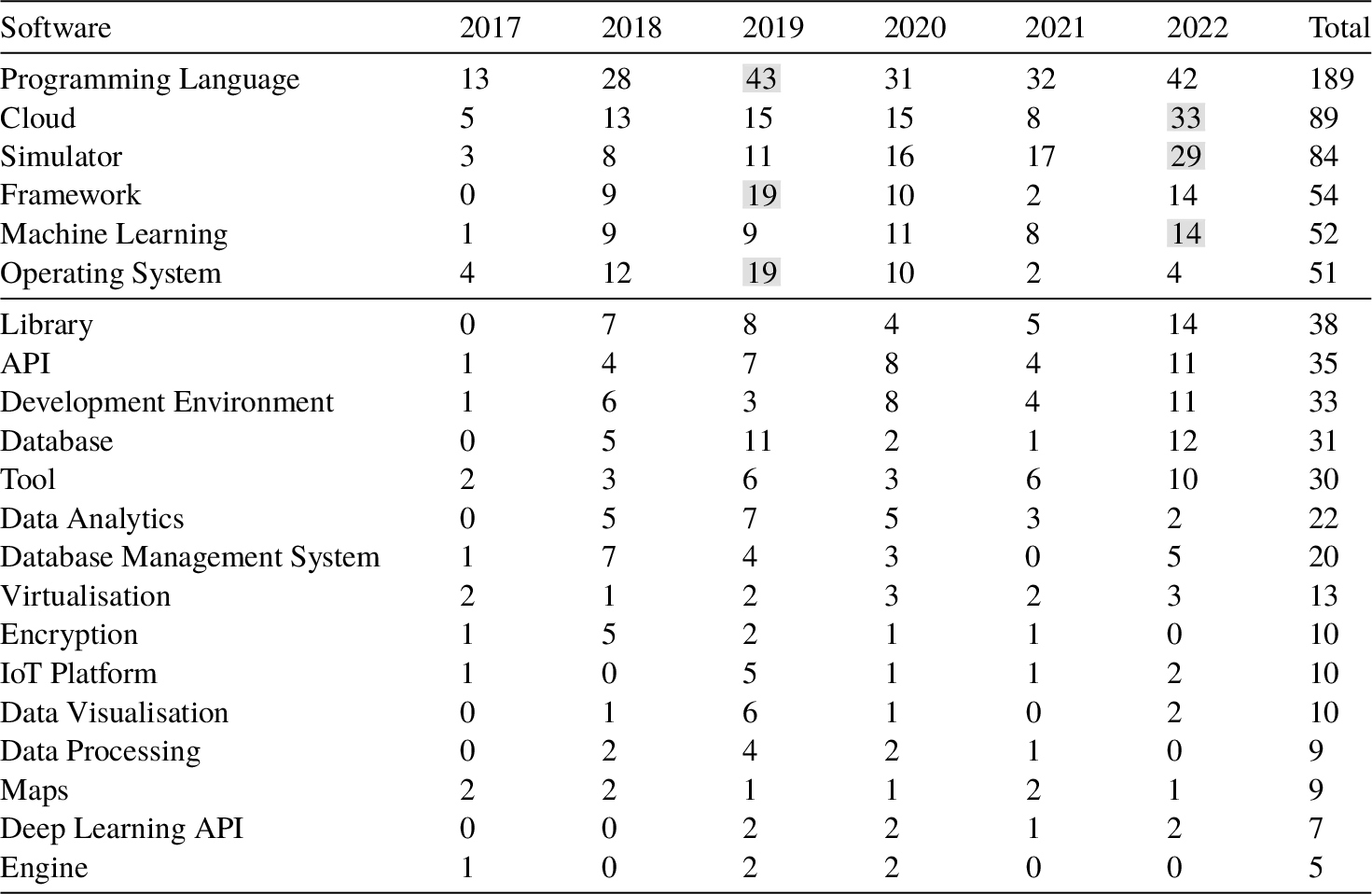
From the data in the table it becomes apparent that there are only six significant software-related terms (outlined by a horizontal line) in the literature on fog computing e-health applications: programming languages, cloud, simulators, frameworks, machine learning and operating systems. “Programming languages” is the term most frequently used in articles, with a number of uses up to three times as low as any other term considered. All significant terms use maximum numbers (marked with the grey background) that vary from 14 to 43 times and appear during the last four years under consideration.
Fig. 4
Total annual mentions of significant terms of software and their linear approximation.
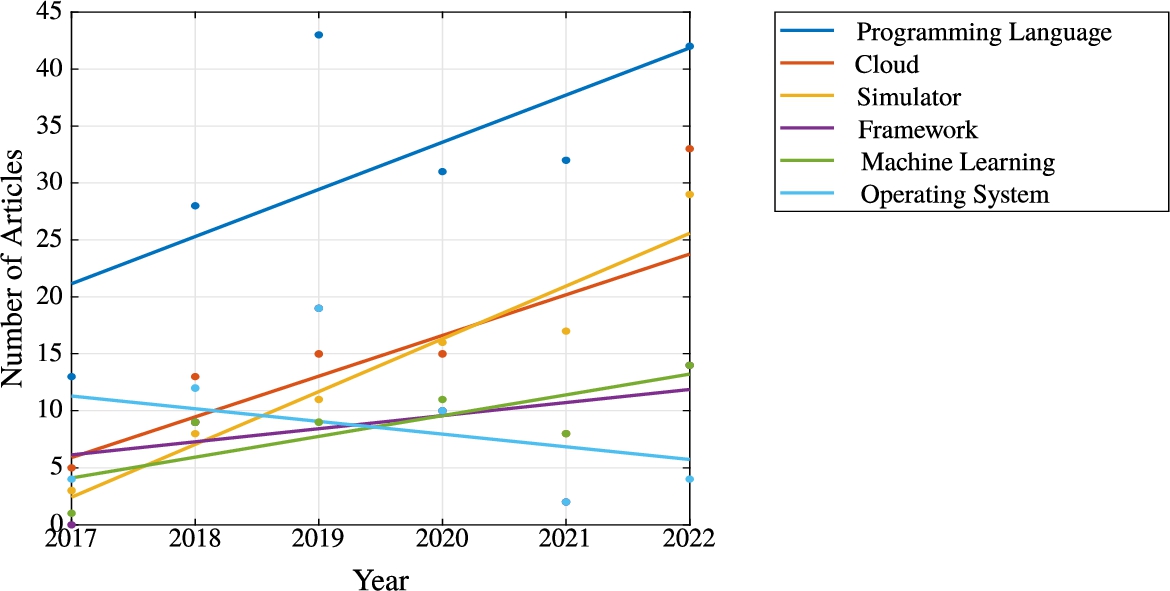
The main trends of significant term use are shown in Fig. 4 using a line fitting to-data technique. From the figure it is evident that three of the six significant terms are trending, i.e. their use during the years 2017–2022 is increasing, which are: “programming languages”, “cloud” and “simulators”. The increase in the usage of terms “machine learning” and “framework” was minimal. Only the trend of the use of the term “operating system” (whose usage in 2019 peaked) is decreasing. It is seen that four terms during the years 2020 and 2021 had a decrease though their use in 2022 peaked.
3.1.3Hardware Perspective
The fog environment commonly consists of few end devices that are heterogeneous, making the system more diverse. When developing fog applications, the computing platform, its devices, and network heterogeneity should be considered. Such systems consist of edge, fog, and cloud layer devices, IoMT, general-use sensors, and sometimes batteries, if devices are mobile. We will separately analyse sensor node and fog node hardware.
Sensor node hardware. In total, 11 most common terms describing sensor node hardware in fog computing e-health applications were chosen and used. The upper part of Table 3 summarises the results on these terms appearing in a representative set of articles.
The table data grounds that in the literature on fog computing e-health applications, there are five significant sensor node hardware-related terms (distinguished from the rest by a horizontal line): sensors, smartphones, microcontroller units (MCU), network modules and specialised sensor nodes. The term “sensor” is the most frequently used term in articles, with a number of uses up to six times lower than any other term considered. All significant terms use maximum numbers (marked with the grey background) that vary from 7 to 71 times and appear from 2019 to 2022.
Table 3
The number of articles that in 2017–2022 addressed a particular hardware of sensor node (upper part) or fog node (lower part) in fog computing e-health applications.
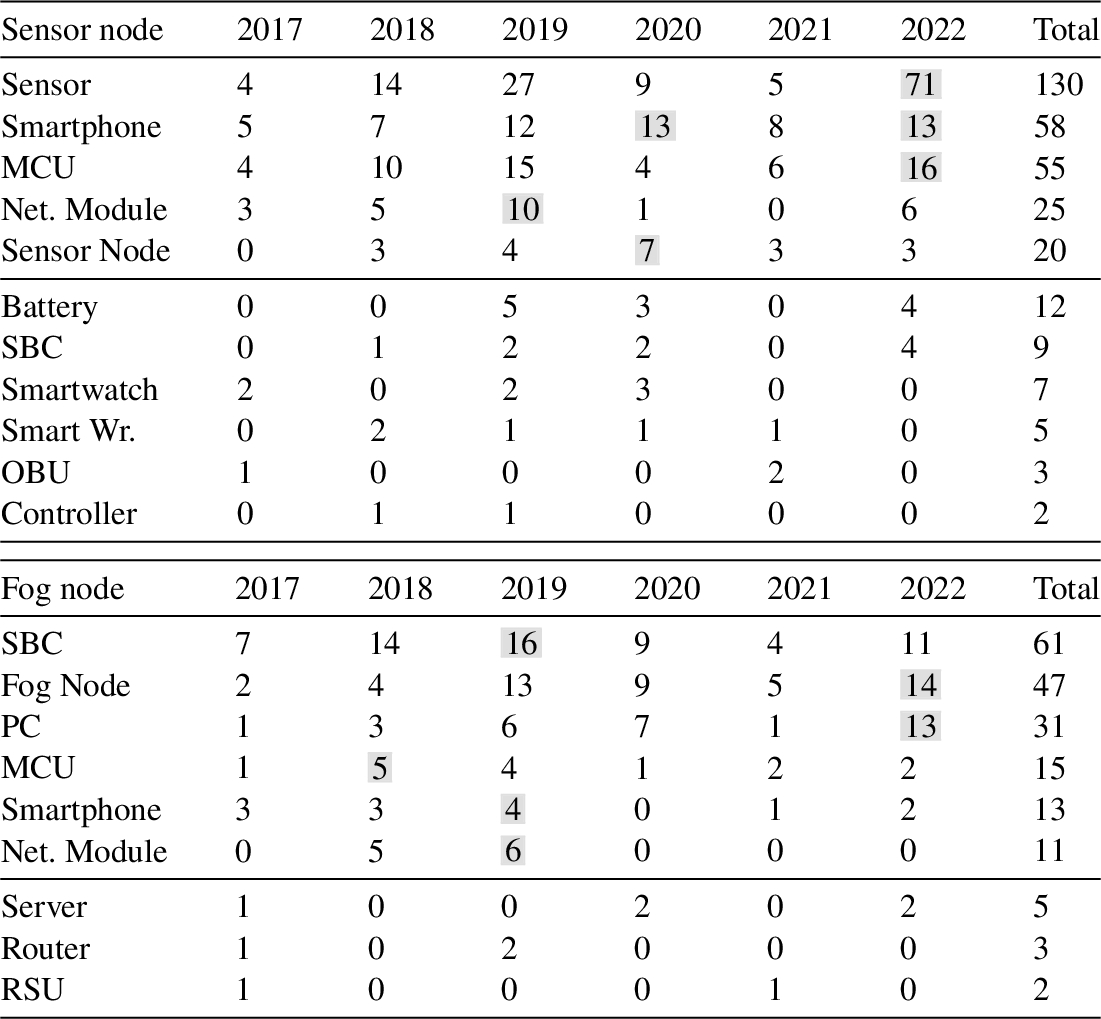
The main trends of significant term use are shown in Fig. 5(a) using a line fitting to-data technique. From the figure it is clear that one of the five significant terms – “sensor” is trending. The increase in the usage of the terms “smartphone” and “MCU” was minimal (which peaked in the last three years) and the decrease in the usage of the term “sensor node” was also minimal (which peaked in 2020). Only the trend of usage of the term “network module” (which peaked in 2019) was decreasing.
Fig. 5
Total annual mentions of significant terms of hardware node type and their linear approximation.
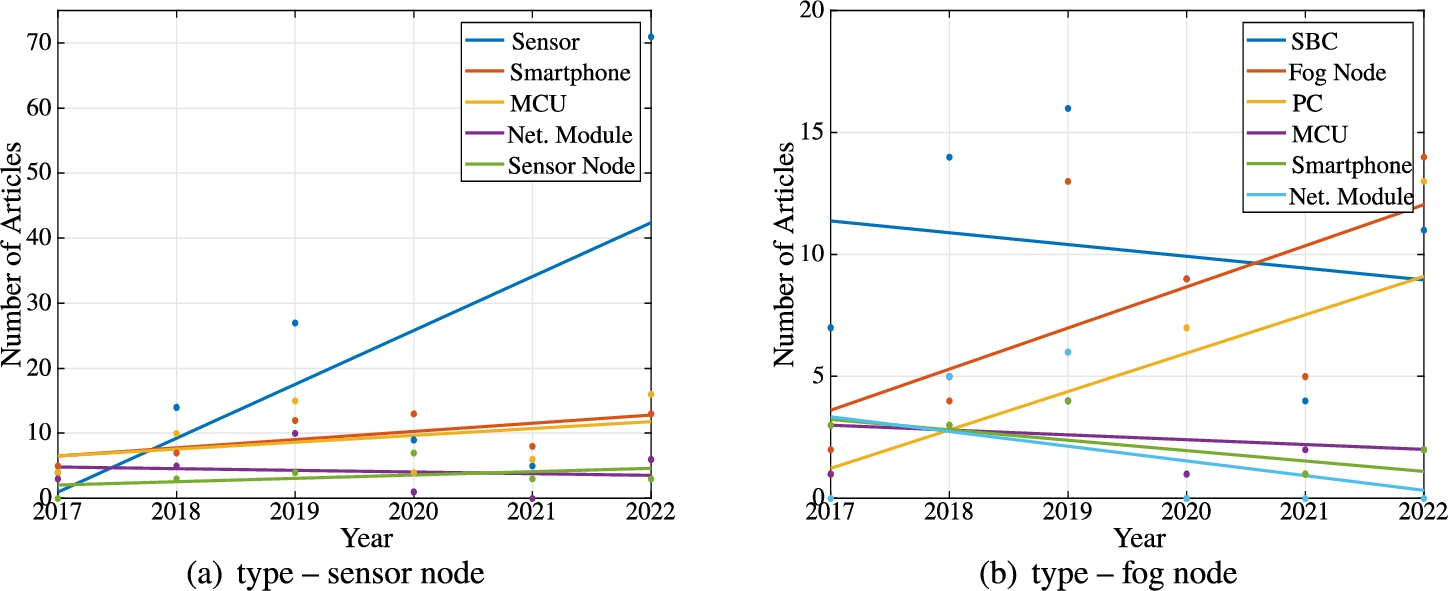
Fog node hardware. In total, 9 most common terms describing fog node hardware in fog computing e-health applications were chosen and used. The lower part of Table 3 summarises the results on these terms appearing in a representative set of articles. There are six significant fog node hardware-related terms (outlined by a horizontal line in the table) in the literature on fog computing e-health applications: single board computers (SBC), specialised fog nodes, more powerful personal computers (PC), microcontroller units (MCU), smartphones and network modules. “SBC” is the most commonly used term in articles, with a number of uses up to five times as low as any other term considered. All significant terms use maximum numbers (marked with the grey background in the table) which vary from 4 to 16 times and appear from 2018 to 2022.
The main trends of significant terms use are shown in Fig. 5(b) using a line fitting to-data technique. From the figure it is evident that two of the six significant terms are trending, the use of terms “fog node” and “PC” during the years 2017–2022 is increasing. The decrease of the usage of terms “SBC”, “MCU” and “smartphone” was minimal, while the usage of “network module” decreased significantly.
3.1.4Information Technologies Perspective
Network resources in the three-tier fog architecture can exist near edge devices in the dedicated fog equipment or within edge devices. This complexity requires the development of middleware that can manage the common pool of device resources, allocate them to application workloads, and work with various network connectivity and data processing technologies.
In total, 14 most common terms describing information technologies in fog computing e-health applications were chosen and used to get a view of the fourth perspective. Table 4 summarises the results on these terms that appear in a representative set of articles.
Table 4
The number of articles that in 2017–2022 addressed particular information technology in fog computing e-health applications.
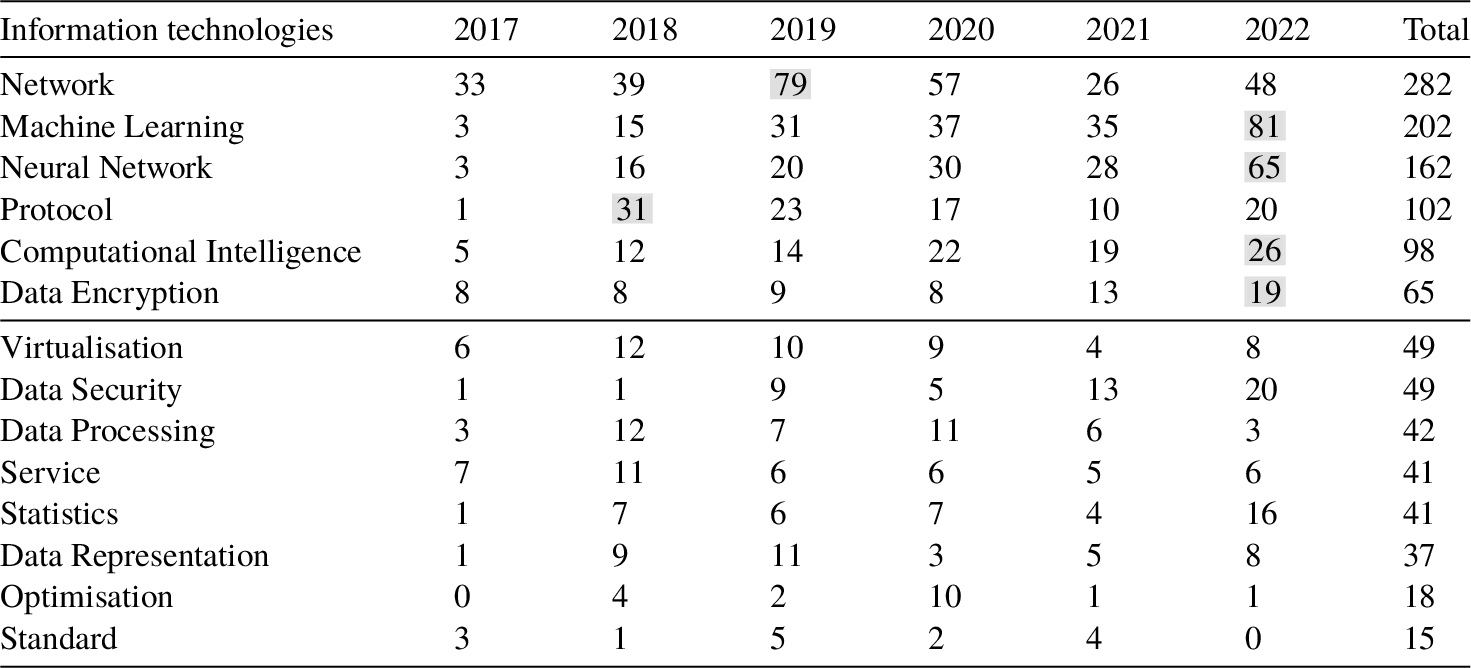
The table data grounds that there are only six significant information technologies-related terms (distinguished from the rest by a horizontal line) in the literature on fog computing e-health applications: networks, machine learning, neural networks, protocols, computational intelligence and data encryption. “Network” is the term most frequently used in articles, with a number of up to four times as low as any other term considered. All significant terms use maximum numbers (marked with the grey background) that vary from 19 to 81 times and appear from 2018 to 2022.
Fig. 6
Total annual mentions of significant information technology terms and their linear approximation.
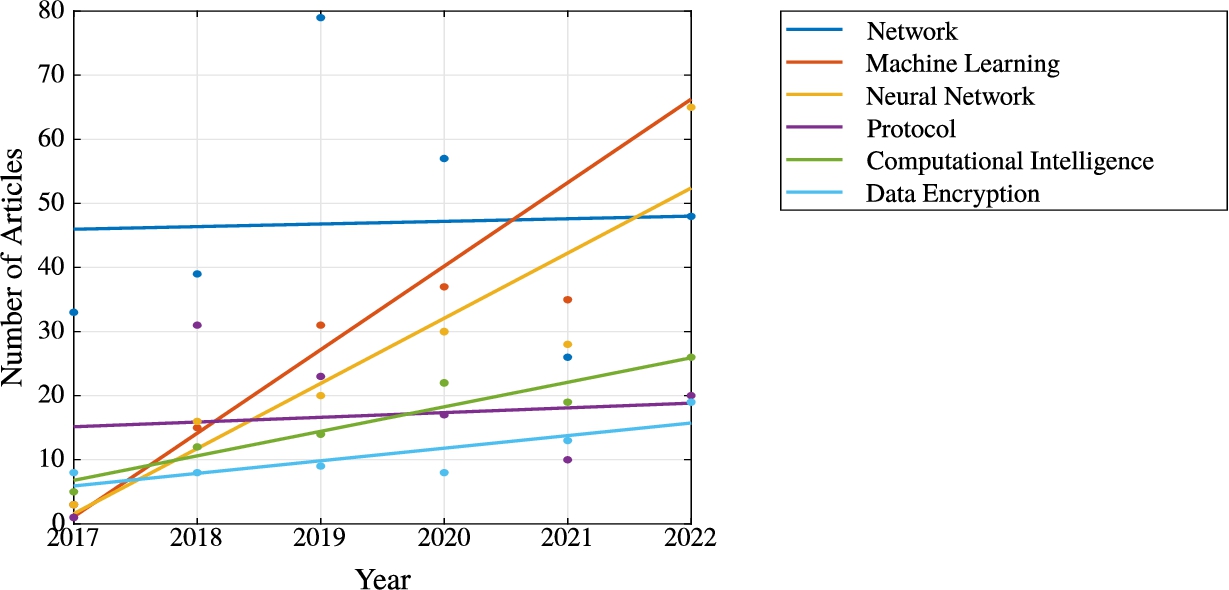
The main trends of significant term use are shown in Fig. 6 using a line fitting to-data technique. From the pictorial representation in the figure it is clear that three of the six significant terms are trending, the use of the terms “machine learning”, “neural network” and “computational intelligence” during the years 2017–2022 is increasing. The increase in the usage of the terms “data encryption”, “network” and “protocol” was minimal (whose use in 2022, 2019 and 2018 peaked accordingly).
3.1.5Mobility with Autonomy Perspective
With the rapidly increasing number of mobile and handheld devices, current computing architectures require computation over anywhere, anytime, and anything connectivity. As people and the computing nodes they use may be mobile, mobility is a barrier to computing in the fog computing environment because some of the data can also be stored at fixed locations. Therefore, the researchers are working on developing solutions for handling mobility, load balancing, task and services migration.
Mobility is one of the newest and least researched aspects of e-health fog computing. Two main groups can be distinguished: mobility of the device or of the service. The types of mobility devices present in the literature include wearable IoT devices or vehicle IoT nodes that can establish a connection with fog nodes distributed in the area.
In total, five most common terms describing mobility with autonomy in fog computing e-health applications were chosen and used to get a view of the fifth perspective. Table 5 summarises the results on these terms that appear in a representative set of articles.
Table 5
The number of articles that in 2017–2022 addressed a particular mobility with autonomy in fog computing e-health applications.

There are two significant terms related to mobility and autonomy in the literature on fog computing e-health applications: wearable IoT devices and vehicle IoT nodes. “Wearable IoT device” is the term most frequently used in articles, with a number of up to three times lower than any other term considered. All significant terms use maximum numbers (on the grey background) that vary from 3 to 8 times and appear from 2020 to 2022.
Fig. 7
Total annual mentions of significant terms of mobility with autonomy and their linear approximation.
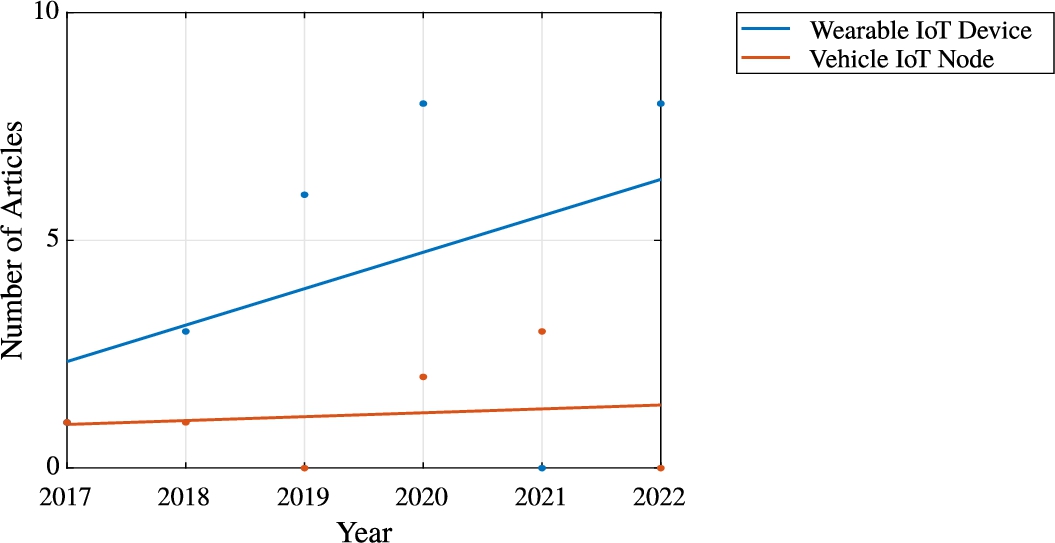
The main trends of significant term use are shown in Fig. 7. From the figure it is clear that one term is trending, even though the use of the term “wearable IoT device” drops in 2021. On the contrary, the increase in the use of the term “vehicle IoT node” is minimal and decreases in years 2019 and 2022, respectively.
3.2The Benefits of Using Artificial Intelligence Techniques for Fog Computing in E-Health
The most important subfields of AI for fog computing e-health applications that we identified are computational intelligence, machine learning and neural networks. Therefore, we present an answer to the second research question from these three perspectives.
3.2.1Computational Intelligence Methods
Computational intelligence (CI) uses a combination of five main paradigms (Engelbrecht, 2007): fuzzy logic, artificial neural networks, evolutionary computing, swarm intelligence, and artificial immune systems. In addition to these paradigms, probabilistic methods are frequently used together with CI techniques, which help deal with uncertainty or imprecision. Due to the popularity and large nomenclature of artificial neural networks, we made the decision to analyse this subset separately.
Table 6
The total number of articles that use a particular CI term.
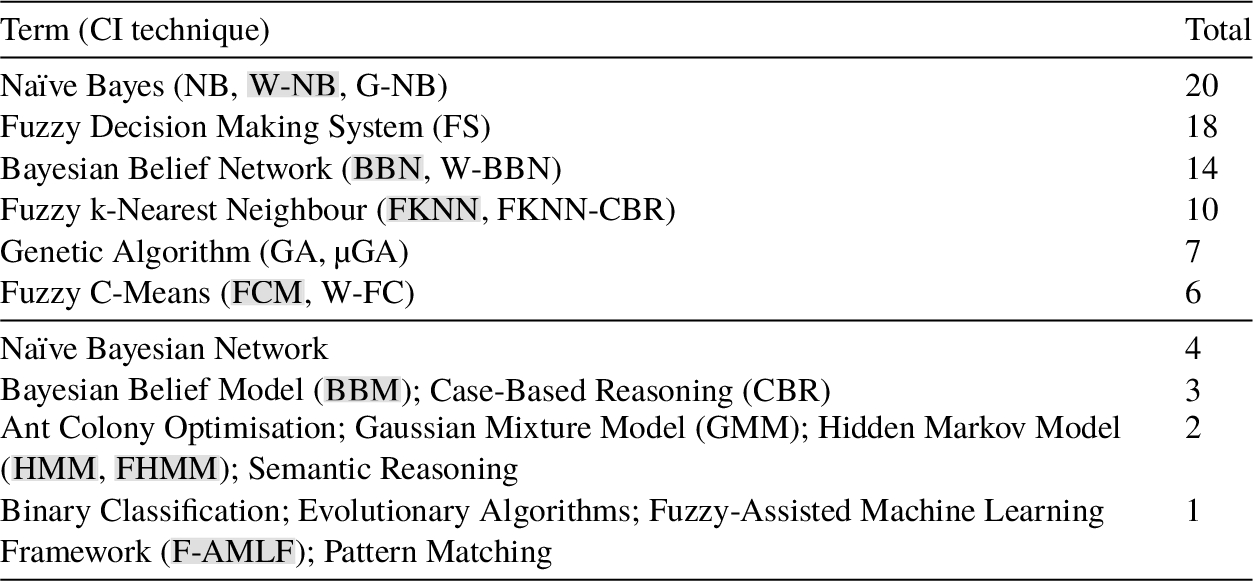
Table 6 presents a list of CI techniques that were applied during our period of investigation of fog computing in e-health. The data in the table are sorted in decreasing order of technique use times, and the statistically significant terms are separated by line. The data point to six significant techniques from 17 in total. Each significant application of the technique was explored in 6 to 20 articles. Moreover, it becomes clear that fuzzy logic based techniques – FS, FKNN, and FCM cover nearly 45%, the sum of all significant applications.
Table 7
Benefits of using CI techniques for fog computing in e-health applications.
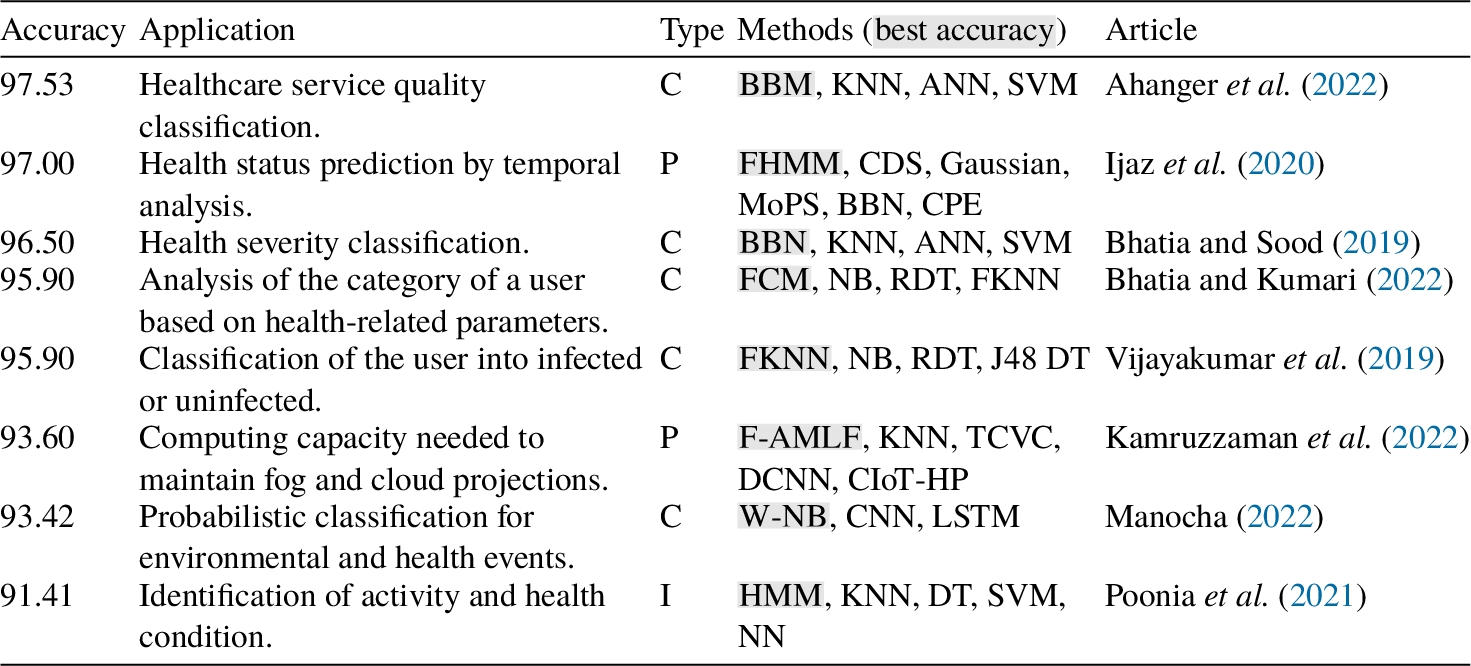
The benefits of using CI techniques for fog computing in e-health applications are revealed in Table 7. Here data from articles about comparative research of CI techniques are summarised – listing achieved accuracy, e-health application, investigated and the best techniques (marked with the grey background). According to Section 2.6, all results are sorted in decreasing order of accuracy. It appears that all the eight best CI techniques – BBM, FHMM, BBN, FCM, FKNN, F-AMLF, W-NB, and HMM, achieve accuracies of 91.41% to 97.53%. Apparently, only BBN, FCM, FKNN and W-NB are significant terms (see Table 6 text on the grey background and above the line). However, the best techniques BBM, FHMM, F-AMLF and HMM require more attention from researchers.
3.2.2Machine Learning Methods
Machine learning (ML) is a subfield of AI. With ML algorithms, a model is built based on sample data, known as training data, to make predictions or decisions. A subset of ML is also related to computational statistics, which focuses on making predictions using computers, but not all ML is statistical learning. The ML field is also impacted by mathematical optimisation theory that delivers methods and applications to the domain.
Table 8 presents a list of ML techniques that were applied in the 2017–2022 period for fog computing in e-health. According to Section 2.6, the data in the table are sorted in decreasing order of technique use times, and the statistically significant terms are separated by line. The data points to five significant techniques out of 33 in total. The applications of each significant technique – SVM, DT, NN, ML, and RF – were explored in 14 to 42 articles. SVM is the most commonly used technique and covers 30% of all significant applications. Apparently, the term “machine learning” that is too general in our context scores fourth.
Table 8
The total number of articles that use a particular ML term.
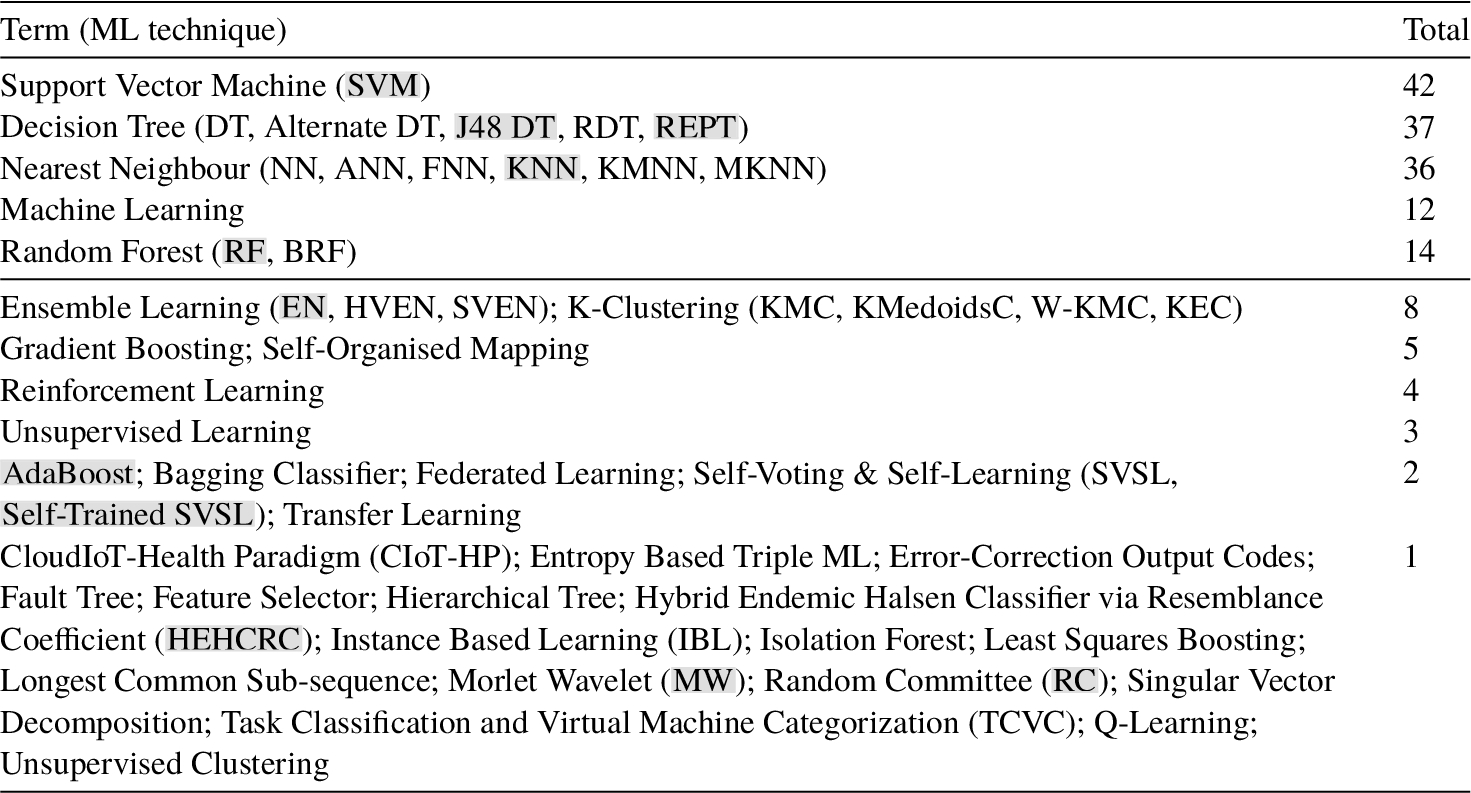
The benefits of using ML techniques for fog computing in e-health applications are shown in Table 9. Here data from articles about ML techniques comparative research is summarised by listing achieved accuracy, e-health application, investigated and the best techniques (shown on the grey background). The data are sorted in decreasing accuracy order.
Table 9
Benefits of using ML techniques for fog computing in e-health applications.

The table data clarify that all of the best 11 ML techniques – SVM, KNN, self-trained SVSL, RF, EN, HEHCRC, RC, J48 DT, MW, REPT, and AdaBoost – achieve accuracies from 79.10% to 99.84%. Apparently, only SVM, KNN, RF, J48 DT, and REPT are significant terms (see the text in Table 8 on the grey background), i.e. fairly addressed in the analyses. Thus, self-trained SVSL, EN, HEHCRC, RC, MW, and AdaBoost require more attention from researchers working in fog computing.
3.2.3Neural Network Methods
Artificial neural networks (ANN) or neural networks (NN), are computing systems inspired by the biological neurons of brains. An ANN is based on an artificial neuron that receives and processes signals and can signal other neurons connected to it. Typically, they are aggregated into layers, the number of which determines the depth of the NN.
Similarly to previous sections, Table 10 presents a list of ANN techniques that were applied during our period of investigation of fog computing in e-health, while Table 11 shows the benefits of using ANN techniques for fog computing in e-health applications.
Table 10
The total number of articles that use a particular ANN term.
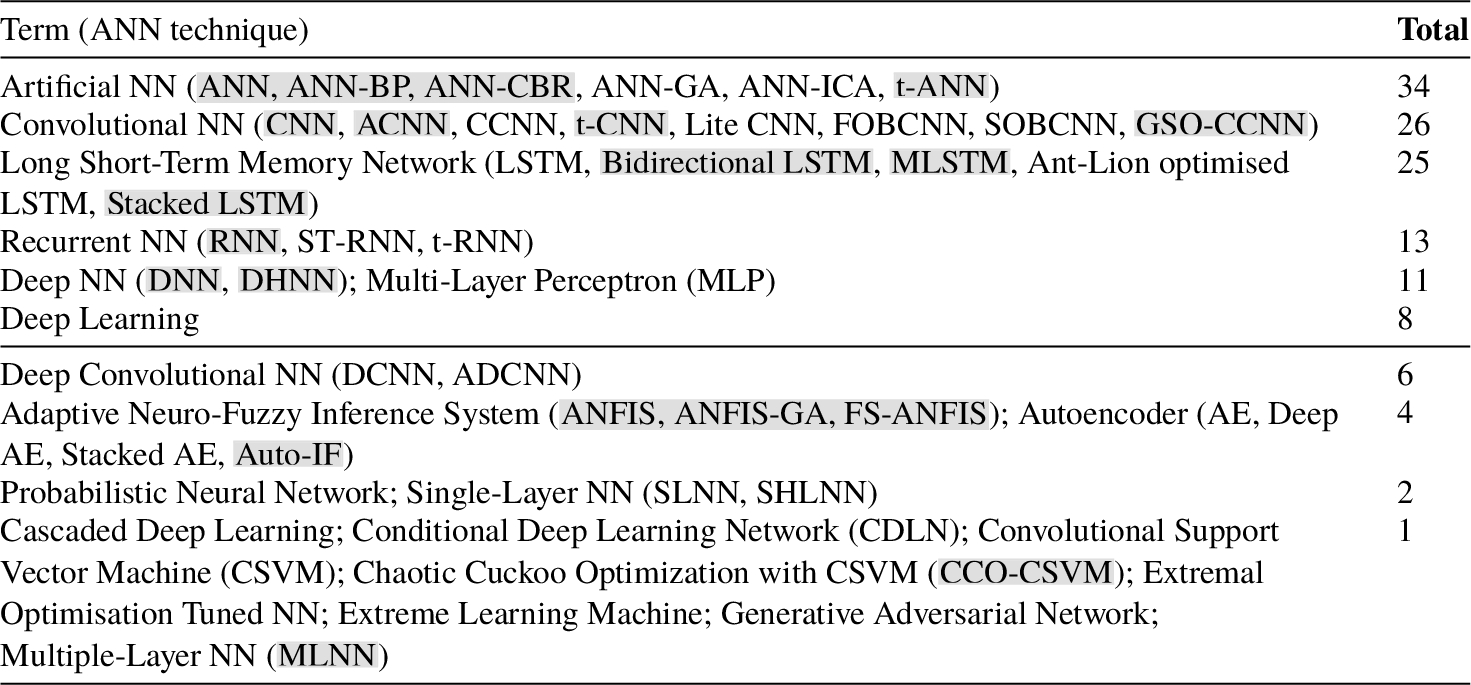
Table 11
Benefitsof using ANN for fog computing in e-health applications.
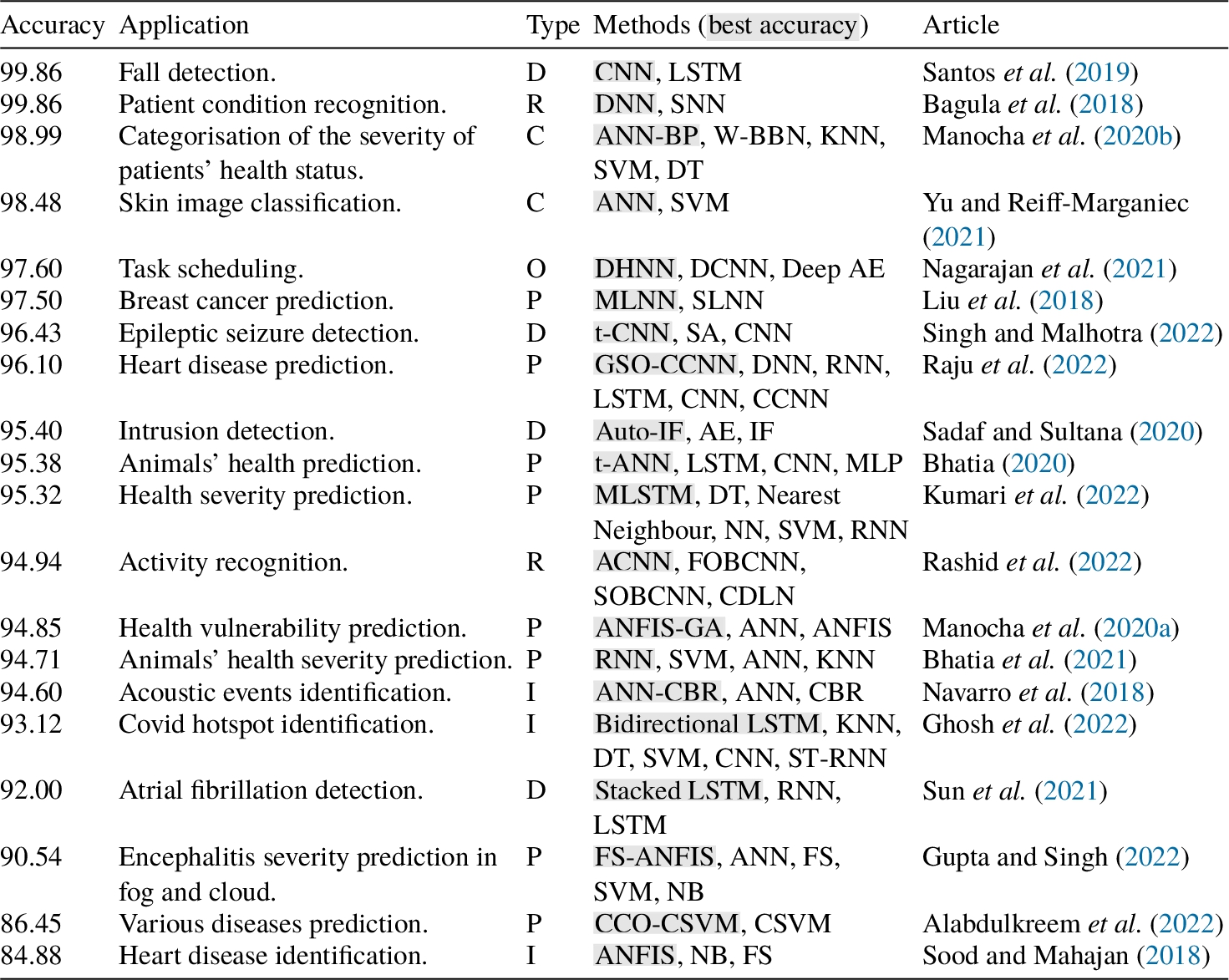
The data in Table 10 point to seven significant techniques (separated by line) – ANN, CNN, LSTM, RNN, DNN, MLP, and Deep Learning – from 20 in total. Each significant application of the technique was explored in 8 to 34 articles. Distinctively, here the term “Artificial neural network” scores first and its usage is 27% of all significant applications. Apparently, the term “deep learning” that is too general in our context scores seventh.
Data from articles on comparative research on ANN techniques are summarised in Table 11. Here, as previously, achieved accuracy of e-health application, investigated, and the best techniques (marked with the grey background) are listed. According to Section 2.6, all results are sorted in decreasing order of accuracy.
It appears that all the best 20 ANN techniques achieve accuracies from 84.88% to 99.86%. Apparently, only CNN, DNN, ANN-BP, ANN, DHNN, t-CNN, t-ANN, MLSTM, ACNN, RNN, ANN-CBR, Bidirectional LSTM, and Stacked LSTM are significant terms (see Table 10 text on the grey background), i.e. fairly addressed in the analysed publications. Thus, more attention from researchers working in fog computing requires such techniques as MLNN, GSO-CCNN, Auto-IF, ANFIS-GA, FS-ANFIS, CCO-CSVM and ANFIS.
4Discussion
Here, the most recent review articles that deal with research in fog computing e-health applications are summarised. Some outcomes of the literature review articles are given in comparison with our findings. Finally, the limitations of our work and conclusions are presented.
4.1Summary of Evidence
To position this systematic review among other review articles, we have created a classification of the most recent review articles that investigated the fog computing paradigm and present it in Table 12. We have chosen to analyse three recent years (from 2020 to 2022) because it is more likely that review authors have researched similar articles as us, and in that way, it also makes it easier to compare all findings. We have classified the review articles into three main themes: the first being relevant to all our chosen analysis perspectives, the second – architectures and design principles, and the third – taxonomy. Further discussion will be based on the review articles presented in the first row of the table.
Table 12
Review articles from 2020 to 2022 dealing with research in fog computing e-health applications.
| Main topic | Review articles |
| Services, software, hardware, information technologies, mobility with autonomy | Doghri et al. (2022); Yaqoob et al. (2022); Khan et al. (2022b); Raoof and Durai (2022); Kashyap et al. (2022); Singh et al. (2022); Alekseeva et al. (2022); Arora et al. (2022); Shirvanian et al. (2022); Hayyolalam et al. (2022); Ahmad et al. (2022); Javaid et al. (2022); Ali et al. (2022); Alkhateeb et al. (2022); Douch et al. (2022); Khan et al. (2022a,c); Quy et al. (2022); Kashani et al. (2021); Ahmadi et al. (2021); Oh et al. (2021); Dhaou et al. (2021); Krishnamoorthy et al. (2023); QingQingChang et al. (2021); Khan et al. (2021); Erhan et al. (2021); Amin and Hossain (2021); Silva and Sofia (2020); Obaidat et al. (2020); Silva et al. (2020); Qiu et al. (2020); Kaur et al. (2020b,a); Swamy and Kota (2020); Uslu et al. (2020); Younan et al. (2020); Prabhu et al. (2020); de Moura Costa et al. (2020); Al-Jaroodi et al. (2020); Aceto et al. (2020); Naresh et al. (2020); Bansal and Kumar (2020); Vilela et al. (2020); Nauman et al. (2020); de Prado et al. (2020); Behmanesh et al. (2020); Farahani et al. (2020) |
| Architectures and design principles | Doghri et al. (2022); Alekseeva et al. (2022); Peng et al. (2022); Javaid et al. (2022); Ali et al. (2022); Douch et al. (2022); Hajam and Sofi (2021); Sisodia and Jindal (2021); Xue et al. (2021); Krishnamoorthy et al. (2023); Amin and Hossain (2021); Obaidat et al. (2020); Swamy and Kota (2020); Uslu et al. (2020); Ahmad et al. (2020); Younan et al. (2020); Qiu et al. (2020); Badidi et al. (2020); Fu et al. (2020); Aazam et al. (2020); Naresh et al. (2020); Bansal and Kumar (2020); Vilela et al. (2020); Nauman et al. (2020); de Prado et al. (2020) |
| Taxonomy | Khan et al. (2022b); Arora et al. (2022); Hayyolalam et al. (2022); Chaudjary et al. (2022); Singh et al. (2021); Kashani et al. (2021); Oh et al. (2021); Sadri et al. (2021); Babar et al. (2021); Obaidat et al. (2020); Silva et al. (2020); Swamy and Kota (2020); Uslu et al. (2020); Javadzadeh and Rahmani (2020); de Moura Costa et al. (2020); Naresh et al. (2020); Bansal and Kumar (2020); Vilela et al. (2020); Nauman et al. (2020); Behmanesh et al. (2020) |
In general, we have noticed that it is very common for most review articles to present lists and descriptions compiling scientific articles about applications, making conclusions on recent and future trends, research directions, open issues, and challenges. In many cases, only the total number of articles is given, while subjective analysis is done only on the most important works. We position this review as systematic and quantitative because it surveys fog computing e-health applications from carefully chosen perspectives, identifies recent trends, and finds benefits of using AI relying on yearly usage of formal terms. Furthermore, the benefits of using AI are elucidated using comparative research articles in selected AI subfields. Thus, our article is original and important to researchers.
In line with the first question Q1, analysing from a software perspective similarly to us, other authors have identified as important topics – virtualisation (Sisodia and Jindal, 2021), deployment of medical IoT applications in the cloud (de Moura Costa et al., 2020; Behmanesh et al., 2020), operating systems and programming languages (Behmanesh et al., 2020), although Sisodia and Jindal (2021) identified additional aspects such as interoperability, decentralisation, real-time capability, service orientation, and modularity.
Looking from a hardware perspective, other authors have also identified the sensor node (Kashani et al., 2021) and fog node (de Moura Costa et al., 2020) categories, and the importance of microcontrollers and development boards (Behmanesh et al., 2020).
Analysing from an information technology perspective similar to us, other authors classified technologies into four categories:
1. Services (de Moura Costa et al., 2020), interoperability (Ahmadi et al., 2021) and offloading (Alekseeva et al., 2022).
2. Data collection, storage, processing (Javadzadeh and Rahmani, 2020; de Moura Costa et al., 2020; Vilela et al., 2020; Behmanesh et al., 2020; Oh et al., 2021; Sadri et al., 2021; Shirvanian et al., 2022), and analysis (near the origin of data and in the cloud) using big data analytics (Vilela et al., 2020; Kashani et al., 2021; Ahmadi et al., 2021; Oh et al., 2021; Krishnamoorthy et al., 2023; Sadri et al., 2021).
3. Networks (Javadzadeh and Rahmani, 2020; Ali et al., 2022) including software-defined networking (Krishnamoorthy et al., 2023), communication standards (Behmanesh et al., 2020; Kashani et al., 2021; Ahmadi et al., 2021), and protocols (de Moura Costa et al., 2020; Behmanesh et al., 2020).
4. Security (de Moura Costa et al., 2020; Kashani et al., 2021; Ahmadi et al., 2021; Krishnamoorthy et al., 2023; Sadri et al., 2021) and privacy (Javadzadeh and Rahmani, 2020), including anonymisation of data (Oh et al., 2021).
From a mobility with autonomy perspective, Behmanesh et al. (2020); Hayyolalam et al. (2022) also identified wearable technology in medicine as an important area with an emphasis on medical sensors and Javaid et al. (2022) emphasised mobile computing.
The authors, who were researching topics similar to our second research question Q2, were seeing the benefits of ML, focussing on its application in database administration, fitness monitoring, real-time health tracking, network QoS and the brain-computer interface (Krishnamoorthy et al., 2023). The move of AI to the edge and fog to compensate for cloud weaknesses and reduce latency was analysed by Greco et al. (2020); Ali et al. (2022). Myoung Lee et al. (2018) suggested that AI would work as a microservice. Gopal et al. (2019) emphasised that value-based AI in healthcare working in intelligent systems is an important part of digital transformation. Chamola et al. (2020) stressed the importance of AI solutions during the Covid-19 pandemic. We also found a survey article on IoT and AI-based smart healthcare (Alshehri and Muhammad, 2021) that tried to collect the accuracy of the technique when conducting their literature research, although it was not that consistent compared to our research due to the varying metrics of the accuracy data collected.
4.2Limitations
This systematic analysis of the literature aimed to provide a comprehensive review in which the analysis was based on the specific terms and the number of articles in which they appeared. However, some limitations of this study should be noted:
• only the literature directly related to fog and health terms was analysed;
• only Web of Science indexed journal articles were considered;
• non-English articles have been ignored;
• we reviewed only articles to which we had full access to;
• employed categorisation of terms is original even though in part it is similar to the other taxonomies proposed in alternative reviews.
4.3Conclusions
To provide a computer scientist with a detailed analysis of the latest research on fog computing in e-health, 1222 articles published between 2017 and 2022 were evaluated, resulting in 374 relevant articles that were later systematically analysed.
The first research question – “What are the recent trends and focus areas in fog computing e-health applications?” is answered from five perspectives:
• from a services perspective, framework, data security, alert generation, and prediction are trending, while monitoring service research is booming and architecture trend is minimally increasing;
• from a software perspective, cloud and simulators are trending, research on programming languages is booming, machine learning and framework trends are minimally increasing, while research using operating systems term is decreasing;
• from a hardware perspective, research of sensor nodes including sensors; fog nodes including specialised fog nodes and personal computers is booming. Interest on sensor nodes including smartphones, microcontroller units and specialised sensor nodes is low, as well as fog node including single board computers, microcontroller units and smartphones with minimal interest decrease. With both hardware types, network module specification is decreasing;
• from an information technologies perspective, ML, ANN and CI uses are trending, when interest increase in data encryption, network and protocols was minimal, at the same time network related research is prevailing;
• from a mobility with autonomy perspective, wearable IoT devices are trending whereas vehicle IoT node usage is minimal.
The second research question – “What are the benefits of using AI techniques for fog computing in e-health?” is answered from three perspectives:
• from a computational intelligence perspective, the research concentrates on BBN, FCM, FKNN, and W-NB together with the more attention required for BBM, FHMM, F-AMLF, and HMM, delivering the best results with the highest accuracy: 97.53% with BBM in healthcare service quality classification; 97% with FHMM in health status prediction; 96.5% with BBN in health severity classification; 91.41% with HMM in health condition identification;
• from a machine learning perspective, fairly addressed in publications SVM, KNN, RF, J48 DT, and REPT together with more attention required self-trained SVSL, EN, HEHCRC, RC, MW, and AdaBoost are delivering the best results with the highest accuracy: 99.84% with SVM in panic health status classification; 98.70% with KNN in heartbeat detection; 97.59% with Self-Trained SVSL in activity recognition;
• from the artificial neural networks perspective, fairly addressed in publications CNN, DNN, ANN-BP, ANN, DHNN, t-CNN, t-ANN, MLSTM, ACNN, RNN, ANN-CBR, Bidirectional LSTM, and Stacked LSTM, together with more attention required MLNN, GSO-CCNN, Auto-IF, ABFIS-GA, FS-ANFIS, CCO-CSVM, and ANFIS, deliver the best results with the highest accuracy: 99.86% with CNN in fall detection; 99.86% with DNN in patient condition recognition; 98.99% with ANN-BP in categorization of severity of patients’ health status; 98.48% with ANN in skin image classification; 97.60% with DHNN in task scheduling; 97.50% with MLNN in breast cancer prediction.
Bibliography availability statement
A full bibliography (as a separate file) is available upon request.
References
1 | Aazam, M., Zeadally, S., Harras, K.A. ((2020) ). Health fog for smart healthcare. IEEE Consumer Electronics Magazine, 9: (2), 96–102. https://doi.org/10.1109/mce.2019.2953749. |
2 | Aceto, G., Persico, V., Pescapé, A. ((2020) ). Industry 4.0 and health: internet of things, big data, and cloud computing for Healthcare 4.0. Journal of Industrial Information Integration, 18: . https://doi.org/10.1016/j.jii.2020.100129. |
3 | Ahanger, T.A., Bhatia, M., Aljumah, A. ((2022) ). Game-theory-inspired novel mechanism for assessing healthcare quality. IEEE Internet of Things Journal, 9: (24), 24856–24865. https://doi.org/10.1109/jiot.2022.3194854. |
4 | Ahmad, S., Afzal, M.M., ALharbi, A. ((2020) ). Big data analytics with fog computing in integrated cloud fog and IoT architecture for smart devices. International Journal of Computer Science and Network Security, 20: (6), 171–177. |
5 | Ahmad, S.G., Iqbal, T., Javaid, A., Munir, E.U., Kirn, N., Jan, S.U., Ramzan, N. ((2022) ). Sensing and artificial intelligent maternal-infant health care systems: a review. Sensors, 22: (12), 4362. https://doi.org/10.3390/s22124362. |
6 | Ahmadi, Z., Kashani, M.H., Nikravan, M., Mahdipour, E. ((2021) ). Fog-based healthcare systems: a systematic review. Multimedia Tools and Applications, 80: (30), 36361–36400. https://doi.org/10.1007/s11042-021-11227-x. |
7 | Al-Fuqaha, A., Guizani, M., Mohammadi, M., Aledhari, M., Ayyash, M. ((2015) ). Internet of Things: a survey on enabling technologies, protocols, and applications. IEEE Communications Surveys & Tutorials, 17: (4), 2347–2376. https://doi.org/10.1109/COMST.2015.2444095. |
8 | Al-Jaroodi, J., Mohamed, N., Abukhousa, E. ((2020) ). Health 4.0: on the way to realizing the healthcare of the future. IEEE Access, 8: , 211189–211210. https://doi.org/10.1109/access.2020.3038858. |
9 | Alabdulkreem, E., Alzahrani, J.S., Eltahir, M.M., Mohamed, A., Hamza, M.A., Motwakel, A., Eldesouki, M.I., Rizwanullah, M. ((2022) ). Cuckoo optimized convolution support vector machine for big health data processing. Computers, Materials & Continua, 73: (2), 3039–3055. https://doi.org/10.32604/cmc.2022.029835. |
10 | Albeshri, A. ((2021) ). SVSL: a human activity recognition method using soft-voting and self-learning. Algorithms, 14: (8), 245. https://doi.org/10.3390/a14080245. |
11 | Aldaej, A. ((2022) ). IoT-inspired smart healthcare framework for diabetic patients: fog computing initiative. International Journal of Innovative Computing Information and Control, 18: (3), 917–939. https://doi.org/10.24507/ijicic.18.03.917. |
12 | Alekseeva, D., Ometov, A., Arponen, O., Lohan, E.S. ((2022) ). The future of computing paradigms for medical and emergency applications. Computer Science Review, 45: , 100494. https://doi.org/10.1016/j.cosrev.2022.100494. |
13 | Ali, O., Ishak, M.K., Bhatti, M.K.L., Khan, I., Kim, K.-I. ((2022) ). A comprehensive review of Internet of Things: technology stack, middlewares, and fog/edge computing interface. Sensors, 22: (3), 995. https://doi.org/10.3390/s22030995. |
14 | Alkhateeb, A., Catal, C., Kar, G., Mishra, A. ((2022) ). Hybrid blockchain platforms for the Internet of Things (IoT): a systematic literature review. Sensors, 22: (4), 1304. https://doi.org/10.3390/s22041304. |
15 | Alshehri, F., Muhammad, G. ((2021) ). A comprehensive survey of the Internet of Things (IoT) and AI-based smart healthcare. IEEE Access, 9: , 3660–3678. https://doi.org/10.1109/access.2020.3047960. |
16 | Amin, S.U., Hossain, M.S. ((2021) ). Edge intelligence and Internet of Things in healthcare: a survey. IEEE Access, 9: , 45–59. https://doi.org/10.1109/access.2020.3045115. |
17 | Arora, D., Gupta, S., Anpalagan, A. ((2022) ). Evolution and adoption of next generation IoT-driven health care 4.0 systems. Wireless Personal Communications, 127: (4), 3533–3613. https://doi.org/10.1007/s11277-022-09932-3. |
18 | Babar, M., Khan, M.S., Ali, F., Imran, M., Shoaib, M. ((2021) ). Cloudlet computing: recent advances, taxonomy, and challenges. IEEE Access, 9: , 29609–29622. https://doi.org/10.1109/access.2021.3059072. |
19 | Badidi, E., Mahrez, Z., Sabir, E. ((2020) ). Fog computing for smart cities’ big data management and analytics: a review. Future Internet, 12: (11), 190. https://doi.org/10.3390/fi12110190. |
20 | Bagula, A., Mandava, M., Bagula, H. ((2018) ). A framework for healthcare support in the rural and low income areas of the developing world. Journal of Network and Computer Applications, 120: , 17–29. https://doi.org/10.1016/j.jnca.2018.06.010. |
21 | Bansal, S., Kumar, D. ((2020) ). IoT ecosystem: a survey on devices, gateways, operating systems, middleware and communication. International Journal of Wireless Information Networks, 27: (3), 340–364. https://doi.org/10.1007/s10776-020-00483-7. |
22 | Behmanesh, A., Sayfouri, N., Sadoughi, F. ((2020) ). Technological features of Internet of Things in medicine: a systematic mapping study. Wireless Communications and Mobile Computing, 2020: , 1–27. https://doi.org/10.1155/2020/9238614. |
23 | Bhatia, M. ((2020) ). Fog computing-inspired smart home framework for predictive veterinary healthcare. Microprocessors and Microsystems, 78: , 103227. https://doi.org/10.1016/j.micpro.2020.103227. |
24 | Bhatia, M., Kumari, S. ((2022) ). A novel IoT-fog-cloud-based healthcare system for monitoring and reventing encephalitis. Cognitive Computation. 14: , 1609–1626. https://doi.org/10.1007/s12559-021-09856-3. |
25 | Bhatia, M., Sood, S.K. ((2019) ). Exploring temporal analytics in fog-cloud architecture for smart office healthcare. Mobile Networks and Applications, 24: (4), 1392–1410. https://doi.org/10.1007/s11036-018-0991-5. |
26 | Bhatia, M., Ahanger, T.A., Tariq, U., Ibrahim, A. ((2021) ). Cognitive intelligence in fog computing-inspired veterinary healthcare. Computers & Electrical Engineering, 91: , 107061. https://doi.org/10.1016/j.compeleceng.2021.107061. |
27 | Bonomi, F. ((2011) ). Connected vehicles, the Internet of Things, and fog computing. In: The Eighth ACM International Workshop on Vehicular Inter-networking (VANET), Las Vegas, USA, pp. 13–15. |
28 | Bonomi, F., Milito, R., Zhu, J., Addepalli, S. ((2012) ). Fog computing and its role in the Internet of Things. In: Proceedings of the First Edition of the MCC Workshop on Mobile Cloud Computing. Association for Computing Machinery, New York, USA, pp. 13–16. 978-1-4503-1519-7. https://doi.org/10.1145/2342509.2342513. |
29 | Busaeed, S., Katib, I., Albeshri, A., Corchado, J.M., Yigitcanlar, T., Mehmood, R. ((2022) ). LidSonic V2.0: a LiDAR and deep-learning-based green assistive edge device to enhance mobility for the visually impaired. Sensors, 22: (19), 7435. https://doi.org/10.3390/s22197435. |
30 | Chakraborty, C., Kishor, A. ((2022) ). Real-time cloud-based patient-centric monitoring using computational health systems. IEEE Transactions on Computational Social Systems, 9: (6), 1613–1623. https://doi.org/10.1109/tcss.2022.3170375. |
31 | Chamola, V., Hassija, V., Gupta, V., Guizani, M. ((2020) ). A comprehensive review of the COVID-19 pandemic and the role of IoT, drones, AI, blockchain, and 5G in managing its impact. IEEE Access, 8: , 90225–90265. https://doi.org/10.1109/access.2020.2992341. |
32 | Chaudjary, S., Kakkar, R., Gupta, R., Tanwar, S., Agrawal, S., Sharma, R. ((2022) ). Blockchain and federated learning-based security solutions for telesurgery system: a comprehensive review. Turkish Journal of Electrical Engineering and Computer Sciences, 30: (7), 2446–2488. https://doi.org/10.55730/1300-0632.3950. |
33 | de Moura Costa, H.J., da Costa, C.A., da Rosa Righi, R., Antunes, R.S. ((2020) ). Fog computing in health: a systematic literature review. Health and Technology, 10: (5), 1025–1044. https://doi.org/10.1007/s12553-020-00431-8. |
34 | de Prado, R.P., García-Galán, S., Muñoz-Expósito, J.E., Marchewka, A., Ruiz-Reyes, N. ((2020) ). Smart containers schedulers for microservices provision in cloud-fog-IoT networks. Challenges and opportunities. Sensors, 20: (6). https://doi.org/10.3390/s20061714. |
35 | Dhaou, I.B., Ebrahimi, M., Ammar, M.B., Bouattour, G., Kanoun, O. ((2021) ). Edge devices for internet of medical things: technologies, techniques, and implementation. Electronics, 10: (17), 2104. https://doi.org/10.3390/electronics10172104. |
36 | Doghri, W., Saddoud, A., Fourati, L.C. ((2022) ). Cyber-physical systems for structural health monitoring: sensing technologies and intelligent computing. The Journal of Supercomputing, 78: (1), 766–809. https://doi.org/10.1007/s11227-021-03875-5. |
37 | Douch, S., Abid, M.R., Zine-Dine, K., Bouzidi, D., Benhaddou, D. ((2022) ). Edge computing technology enablers: a systematic lecture study. IEEE Access, 10: , 69264–69302. https://doi.org/10.1109/access.2022.3183634. |
38 | El-Hasnony, I.M., Mostafa, R.R., Elhoseny, M., Barakat, S.I. (2020). Leveraging mist and fog for big data analytics in IoT environment. Transactions on Emerging Telecommunications Technologies. https://doi.org/10.1002/ett.4057. |
39 | Engelbrecht, A.P. ((2007) ). Computational Intelligence: An Introduction. 2nd edition, Wiley, West Sussex, UK, pp. 640. 978-0-470-03561-0. |
40 | Erhan, L., Ndubuaku, M., Mauro, M.D., Song, W., Chen, M., Fortino, G., Bagdasar, O., Liotta, A. ((2021) ). Smart anomaly detection in sensor systems: a multi-perspective review. Information Fusion, 67: , 64–79. https://doi.org/10.1016/j.inffus.2020.10.001. |
41 | Farahani, B., Barzegari, M., Aliee, F.S., Shaik, K.A. ((2020) ). Towards collaborative intelligent IoT eHealth: from device to fog, and cloud. Microprocessors and Microsystems, 72: . https://doi.org/10.1016/j.micpro.2019.102938. |
42 | Fu, C., Lv, Q., Badrnejad, R.G. ((2020) ). Fog computing in health management processing systems. Kybernetes, 49: (12), 2893–2917. https://doi.org/10.1108/k-09-2019-0621. |
43 | Ghosh, S., Mukherjee, A., Ghosh, S.K., Buyya, R. ((2022) ). STOPPAGE: spatio-temporal data driven cloud-fog-edge computing framework for pandemic monitoring and management. Software: Practice and Experience, 52: (12), 2700–2726. https://doi.org/10.1002/spe.3144. |
44 | Gopal, G., Suter-Crazzolara, C., Toldo, L., Eberhardt, W. ((2019) ). Digital transformation in healthcare – architectures of present and future information technologies. Clinical Chemistry and Laboratory Medicine (CCLM), 57: (3), 328–335. https://doi.org/doi:10.1515/cclm-2018-0658. |
45 | Greco, L., Percannella, G., Ritrovato, P., Tortorella, F., Vento, M. ((2020) ). Trends in IoT based solutions for health care: moving AI to the edge. Pattern Recognition Letters, 135: , 346–353. https://doi.org/10.1016/j.patrec.2020.05.016. |
46 | Gu, F., Niu, J., Jin, X., Yu, S. ((2020) ). FDFA: a fog computing assisted distributed analytics and detecting system for family activities. Peer-to-Peer Networking and Applications, 13: (1), 38–52. https://doi.org/10.1007/s12083-018-0714-5. |
47 | Gupta, A., Singh, A. ((2022) ). An intelligent healthcare cyber physical framework for encephalitis diagnosis based on information fusion and soft-computing techniques. New Generation Computing, 40: (4), 1093–1123. https://doi.org/10.1007/s00354-022-00175-1. |
48 | Hajam, S.S., Sofi, S.A. ((2021) ). IoT-Fog architectures in smart city applications: a survey. China Communications, 18: (11), 117–140. https://doi.org/10.23919/jcc.2021.11.009. |
49 | Hayyolalam, V., Aloqaily, M., Ozkasap, O., Guizani, M. ((2022) ). Edge-assisted solutions for IoT-based connected healthcare systems: a literature review. IEEE Internet of Things Journal, 9: (12), 9419–9443. https://doi.org/10.1109/jiot.2021.3135200. |
50 | Ijaz, M., Li, G., Wang, H., El-Sherbeeny, A.M., Awelisah, Y.M., Lin, L., Koubaa, A., Noor, A. ((2020) ). Intelligent fog-enabled smart healthcare system for wearable physiological parameter detection. Electronics, 9: (12), 2015. https://doi.org/10.3390/electronics9122015. |
51 | Javadzadeh, G., Rahmani, A.M. ((2020) ). Fog computing applications in smart cities: a systematic survey. Wireless Networks, 26: (2), 1433–1457. https://doi.org/10.1007/s11276-019-02208-y. |
52 | Javaid, S., Zeadally, S., Fahim, H., He, B. ((2022) ). Medical sensors and their integration in wireless body area networks for pervasive healthcare delivery: a review. IEEE Sensors Journal, 22: (5), 3860–3877. https://doi.org/10.1109/jsen.2022.3141064. |
53 | Kamruzzaman, M.M., Alanazi, S., Alruwaili, M., Alrashdi, I., Alhwaiti, Y., Alshammari, N. ((2022) ). Fuzzy-assisted machine learning framework for the fog-computing system in remote healthcare monitoring. Measurement, 195: , 111085. https://doi.org/10.1016/j.measurement.2022.111085. |
54 | Kanani, P., Padole, M. ((2020) ). Exploring and optimizing the fog computing in different dimensions. Procedia Computer Science, 171: , 2694–2703. https://doi.org/10.1016/j.procs.2020.04.292. |
55 | Kashani, M.H., Madanipour, M., Nikravan, M., Asghari, P., Mahdipour, E. ((2021) ). A systematic seview of IoT in healthcare: applications, techniques, and trends. Journal of Network and Computer Applications, 192: , 103164. https://doi.org/10.1016/j.jnca.2021.103164. |
56 | Kashyap, V., Kumar, A., Kumar, A., Hu, Y.-C. ((2022) ). A systematic survey on fog and IoT driven healthcare: open challenges and research issues. Electronics, 11: (17), 2668. https://doi.org/10.3390/electronics11172668. |
57 | Kaur, J., Agrawal, A., Khan, R.A. ((2020) a). Security issues in fog environment: a systematic literature review. International Journal of Wireless Information Networks, 27: (3), 467–483. https://doi.org/10.1007/s10776-020-00491-7. |
58 | Kaur, R., Pasricha, R., Kaur, B. ((2020) b). A study of wireless body area networks and its routing protocols for healthcare environment. Recent Advances in Electrical & Electronic Engineering (Formerly Recent Patents on Electrical & Electronic Engineering), 13: (2), 136–152. https://doi.org/10.2174/2352096512666190305152857. |
59 | Khan, J.I., Khan, J., Ali, F., Ullah, F., Bacha, J., Lee, S. ((2022) a). Artificial Intelligence and Internet of Things (AI-IoT) technologies in response to COVID-19 pandemic: a systematic review. IEEE Access, 10: , 62613–62660. https://doi.org/10.1109/access.2022.3181605. |
60 | Khan, M.A., Din, I.U., Majali, T., Kim, B.-S. ((2022) b). A survey of authentication in Internet of Things-enabled healthcare systems. Sensors, 22: (23), 9089. https://doi.org/10.3390/s22239089. |
61 | Khan, M.N., Rao, A., Camtepe, S. ((2021) ). Lightweight cryptographic protocols for IoT-constrained devices: a survey. IEEE Internet of Things Journal, 8: (6), 4132–4156. https://doi.org/10.1109/jiot.2020.3026493. |
62 | Khan, S., Arslan, T., Ratnarajah, T. ((2022) c). Digital twin perspective of fourth industrial and healthcare revolution. IEEE Access, 10: , 25732–25754. https://doi.org/10.1109/access.2022.3156062. |
63 | Krishnamoorthy, S., Dua, A., Gupta, S. ((2023) ). Role of emerging technologies in future IoT-driven Healthcare 4.0 technologies: a survey, current challenges and future directions. Journal of Ambient Intelligence and Humanized Computing. 14: , 361–407. https://doi.org/10.1007/s12652-021-03302-w. |
64 | Kumar, P., Gupta, G.P., Tripathi, R. ((2021) ). An ensemble learning and fog-cloud architecture-driven cyber-attack detection framework for IoMT networks. Computer Communications, 166: , 110–124. https://doi.org/10.1016/j.comcom.2020.12.003. |
65 | Kumari, S., Bhatia, M., Stea, G. ((2022) ). Fog-computing based healthcare framework for predicting encephalitis outbreak. Big Data Research, 29: , 100330. https://doi.org/10.1016/j.bdr.2022.100330. |
66 | Linthicum, D.S. ((2017) ). Connecting fog and cloud computing. IEEE Cloud Computing, 4: (2), 18–20. https://doi.org/10.1109/MCC.2017.37. |
67 | Liu, X., Deng, R.H., Yang, Y., Tran, H.N., Zhong, S. ((2018) ). Hybrid privacy-preserving clinical decision support system in fog-cloud computing. Future Generation Computer Systems, 78: (2), 825–837. https://doi.org/10.1016/j.future.2017.03.018. |
68 | Maki, O., Alshaikhli, M., Gunduz, M., Naji, K.K., Abdulwahed, M. ((2022) ). Development of digitalization road map for healthcare facility management. IEEE Access, 10: , 14450–14462. https://doi.org/10.1109/access.2022.3146341. |
69 | Manocha, A. ((2022) ). IoT-assisted irregular environmental event determination for health analysis of pregnant females. Transactions on Emerging Telecommunications Technologies, 33: (1). https://doi.org/10.1002/ett.4392. |
70 | Manocha, A., Singh, R., Bhatia, M. ((2020) a). Cognitive intelligence assisted fog-cloud architecture for Generalized Anxiety Disorder (GAD) prediction. Journal of Medical Systems, 44: (1). https://doi.org/10.1007/s10916-019-1495-y. |
71 | Manocha, A., Singh, R., Verma, P. ((2020) b). An internet of things fog-assisted sleep-deprivation prediction framework for spinal cord injury patients. Computer, 53: (2), 46–56. https://doi.org/10.1109/mc.2019.2916829. |
72 | Myoung Lee, G., Um, T.-W., Choi, J.K. ((2018) ). AI as a Microservice (AIMS) over networks. In: 2018 ITU Kaleidoscope: Machine Learning for a 5G Future (ITU K), Santa Fe, Argentina, pp. 1–7. https://doi.org/10.23919/ITU-WT.2018.8597704. |
73 | Nagarajan, S.M., Deverajan, G.G., Chatterjee, P., Alnumay, W., Ghosh, U. ((2021) ). Effective task scheduling algorithm with deep learning for Internet of Health Things (IoHT) in sustainable smart cities. Sustainable Cities and Society, 71: , 102945. https://doi.org/10.1016/j.scs.2021.102945. |
74 | Naresh, V.S., Pericherla, S.S., Murty, P.S.R., Reddi, S. ((2020) ). Internet of Things in healthcare: architecture, applications, challenges, and solutions. Computer Systems Science and Engineering, 35: (6), 411–421. https://doi.org/10.32604/csse.2020.35.411. |
75 | Nauman, A., Qadri, Y.A., Amjad, M., Zikria, Y.B., Afzal, M.K., Kim, S.W. ((2020) ). Multimedia Internet of Things: a comprehensive survey. IEEE Access, 8: , 8202–8250. https://doi.org/10.1109/access.2020.2964280. |
76 | Navarro, J., Vidaña-Vila, E., Alsina-Pagès, R., Hervás, M. ((2018) ). Real-time distributed architecture for remote acoustic elderly monitoring in residential-scale ambient assisted living scenarios. Sensors, 18: (8), 2492. https://doi.org/10.3390/s18082492. |
77 | Obaidat, M.A., Obeidat, S., Holst, J., Hayajneh, A.A., Brown, J. ((2020) ). A comprehensive and systematic survey on the Internet of Things: security and privacy challenges, security frameworks, enabling technologies, threats, vulnerabilities and countermeasures. Computers, 9: (2), 44. https://doi.org/10.3390/computers9020044. |
78 | Oh, S.-R., Seo, Y.-D., Lee, E., Kim, Y.-G. ((2021) ). A comprehensive survey on security and privacy for electronic health data. International Journal of Environmental Research and Public Health, 18: (18), 9668. https://doi.org/10.3390/ijerph18189668. |
79 | Page, M.J., McKenzie, J.E., Bossuyt, P.M., Boutron, I., Hoffmann, T.C., Mulrow, C.D., Shamseer, L., Tetzlaff, J.M., Akl, E.A., Brennan, S.E., Chou, R., Glanville, J., Grimshaw, J.M., Hróbjartsson, A., Lalu, M.M., Li, T., Loder, E.W., Mayo-Wilson, E., McDonald, S., McGuinness, L.A., Stewart, L.A., Thomas, J., Tricco, A.C., Welch, V.A., Whiting, P., Moher, D. ((2021) ). The PRISMA 2020 statement: an updated guideline for reporting systematic reviews. BMJ, 372: . https://doi.org/10.1136/bmj.n71. |
80 | Peng, D., Sun, L., Zhou, R., Wang, Y. (2022). Study QoS-aware fog computing for disease diagnosis and prognosis. Mobile Networks and Applications. https://doi.org/10.1007/s11036-022-01957-z. |
81 | Poonia, A., Ghosh, S., Ghosh, A., Nath, S.B., Ghosh, S.K., Buyya, R. ((2021) ). CONFRONT: cloud-fog-dew based monitoring framework for COVID-19 management. Internet of Things, 16: , 100459. https://doi.org/10.1016/j.iot.2021.100459. |
82 | Prabhu, C.S.R., Jan, T., Prasad, M., Varadarajan, V. (2020). Fog analytics – a survey. Malaysian Journal of Computer Science, 140–151. https://doi.org/10.22452/mjcs.sp2020no1.10. |
83 | QingQingChang, Ahmad, I., Liao, X., Nazir, S. ((2021) ). Evaluation and quality assurance of fog computing-based IoT for health monitoring system. Wireless Communications and Mobile Computing, 2021: , 1–12. https://doi.org/10.1155/2021/5599907. |
84 | Qiu, T., Chi, J., Zhou, X., Ning, Z., Atiquzzaman, M., Wu, D.O. ((2020) ). Edge computing in industrial Internet of Things: architecture, advances and challenges. IEEE Communications Surveys & Tutorials, 22: (4), 2462–2488. https://doi.org/10.1109/comst.2020.3009103. |
85 | Quy, V.K., Hau, N.V., Anh, D.V., Ngoc, L.A. ((2022) ). Smart healthcare IoT applications based on fog computing: architecture, applications and challenges. Complex & Intelligent Systems. 8: , 3805–3815. https://doi.org/10.1007/s40747-021-00582-9. |
86 | Raju, K.B., Dara, S., Vidyarthi, A., Gupta, V.M., Khan, B. ((2022) ). Smart heart disease prediction system with IoT and fog computing sectors enabled by cascaded deep learning model. Computational Intelligence and Neuroscience, 2022: , 1–22. https://doi.org/10.1155/2022/1070697. |
87 | Raoof, S.S., Durai, M.A.S. ((2022) ). A comprehensive review on smart health care: applications, paradigms, and challenges with case studies. Contrast Media & Molecular Imaging, 2022: , 1–18. https://doi.org/10.1155/2022/4822235. |
88 | Rashid, N., Demirel, B.U., Faruque, M.A.A. ((2022) ). AHAR: adaptive CNN for energy-efficient human activity recognition in low-power edge devices. IEEE Internet of Things Journal, 9: (15), 13041–13051. https://doi.org/10.1109/jiot.2022.3140465. |
89 | Ribeiro, O., Gomes, L., Vale, Z. ((2022) ). IoT-based human fall detection system. Electronics, 11: (4), 592. https://doi.org/10.3390/electronics11040592. |
90 | Sadaf, K., Sultana, J. ((2020) ). Intrusion detection based on autoencoder and isolation forest in fog computing. IEEE Access, 8: , 167059–167068. https://doi.org/10.1109/access.2020.3022855. |
91 | Sadri, A.A., Rahmani, A.M., Saberikamarposhti, M., Hosseinzadeh, M. ((2021) ). Fog data management: a vision, challenges, and future directions. Journal of Network and Computer Applications, 174: , 102882. https://doi.org/10.1016/j.jnca.2020.102882. |
92 | Sahil, Sood, S.K. ((2022) ). Fog-Cloud centric IoT-based cyber physical framework for panic oriented disaster evacuation in smart cities. Earth Science Informatics, 15: , 1449–1470. https://doi.org/10.1007/s12145-020-00481-6. |
93 | Santos, G., Endo, P., Monteiro, K., Rocha, E., Silva, I., Lynn, T. ((2019) ). Accelerometer-based human fall detection using convolutional neural networks. Sensors, 19: (7), 1644. https://doi.org/10.3390/s19071644. |
94 | Scirè, A., Tropeano, F., Anagnostopoulos, A., Chatzigiannakis, I. ((2019) ). Fog-computing-based heartbeat detection and arrhythmia classification using machine learning. Algorithms, 12: (2), 32. https://doi.org/10.3390/a12020032. |
95 | Shirvanian, N., Shams, M., Rahmani, A.M. ((2022) ). Internet of Things data management: a systematic literature review, vision, and future trends. International Journal of Communication Systems, 35: (14). https://doi.org/10.1002/dac.5267. |
96 | Silva, D.M.A.D., Sofia, R.C. ((2020) ). A discussion on context-awareness to better support the IoT cloud/edge continuum. IEEE Access, 8: , 193686–193694. https://doi.org/10.1109/access.2020.3032388. |
97 | Silva, F.S.D., Silva, E., Neto, E.P., Lemos, M., Neto, A.J.V., Esposito, F. ((2020) ). A taxonomy of DDoS attack mitigation approaches featured by SDN technologies in IoT scenarios. Sensors, 20: (11). https://doi.org/10.3390/s20113078. |
98 | Singh, D., Singh, R., Gehlot, A., Akram, S.V., Priyadarshi, N., Twala, B. ((2022) ). An imperative role of digitalization in monitoring cattle health for sustainability. Electronics, 11: (17), 2702. https://doi.org/10.3390/electronics11172702. |
99 | Singh, J., Singh, P., Gill, S.S. ((2021) ). Fog computing: a taxonomy, systematic review, current trends and research challenges. Journal of Parallel and Distributed Computing, 157: , 56–85. https://doi.org/10.1016/j.jpdc.2021.06.005. |
100 | Singh, K., Malhotra, J. ((2022) ). Smart neurocare approach for detection of epileptic seizures using deep learning based temporal analysis of EEG patterns. Multimedia Tools and Applications, 81: (20), 29555–29586. https://doi.org/10.1007/s11042-022-12512-z. |
101 | Sisodia, A., Jindal, R. ((2021) ). A meta-analysis of Industry 4.0 design principles applied in the health sector. Engineering Applications of Artificial Intelligence, 104: , 104377. https://doi.org/10.1016/j.engappai.2021.104377. |
102 | Sood, S.K., Mahajan, I. ((2018) ). A fog assisted cyber-physical framework for identifying and preventing coronary heart disease. Wireless Personal Communications, 101: (1), 143–165. https://doi.org/10.1007/s11277-018-5680-y. |
103 | Suggala, R.K., Krishna, M.V., Swain, S.K. ((2022) ). Health monitoring jeopardy prophylaxis model based on machine learning in fog computing. Transactions on Emerging Telecommunications Technologies, 33: (7). https://doi.org/10.1002/ett.4497. |
104 | Sun, L., Yu, Q., Peng, D., Subramani, S., Wang, X. ((2021) ). FogMed: a fog-based framework for disease prognosis based medical sensor data streams. Computers, Materials & Continua, 66: (1), 603–619. https://doi.org/10.32604/cmc.2020.012515. |
105 | Swamy, S.N., Kota, S.R. ((2020) ). An empirical study on system level aspects of Internet of Things (IoT). IEEE Access, 8: , 188082–188134. https://doi.org/10.1109/access.2020.3029847. |
106 | Uslu, B.Ç., Okay, E., Dursun, E. ((2020) ). Analysis of factors affecting IoT-based smart hospital design. Journal of Cloud Computing, 9: (1). https://doi.org/10.1186/s13677-020-00215-5. |
107 | Vijayakumar, V., Malathi, D., Subramaniyaswamy, V., Saravanan, P., Logesh, R. ((2019) ). Fog computing-based intelligent healthcare system for the detection and prevention of mosquito-borne diseases. Computers in Human Behavior, 100: , 275–285. https://doi.org/10.1016/j.chb.2018.12.009. |
108 | Vilela, P.H., Rodrigues, J.J.P.C., da R. Righi, R., Kozlov, S., Rodrigues, V.F. ((2020) ). Looking at fog computing for e-health through the lens of deployment challenges and applications. Sensors, 20: (9). https://doi.org/10.3390/s20092553. |
109 | Xue, D., Nazir, S., Peng, Z., Khattak, H. ((2021) ). Selection and ranking of fog computing-based IoT for monitoring of health using the analytic network approach. Complexity, 2021: , 1–11. https://doi.org/10.1155/2021/9964303. |
110 | Yaqoob, I., Salah, K., Jayaraman, R., Al-Hammadi, Y. ((2022) ). Blockchain for healthcare data management: opportunities, challenges, and future recommendations. Neural Computing and Applications. 34: , 11475–11490. https://doi.org/10.1007/s00521-020-05519-w. |
111 | Younan, M., Houssein, E.H., Elhoseny, M., Ali, A.A. ((2020) ). Challenges and recommended technologies for the industrial Internet of Things: a comprehensive review. Measurement, 151: . https://doi.org/10.1016/j.measurement.2019.107198. |
112 | Yu, H.Q., Reiff-Marganiec, S. ((2021) ). Targeted ensemble machine classification approach for supporting IoT enabled skin disease detection. IEEE Access, 9: , 50244–50252. https://doi.org/10.1109/access.2021.3069024. |




